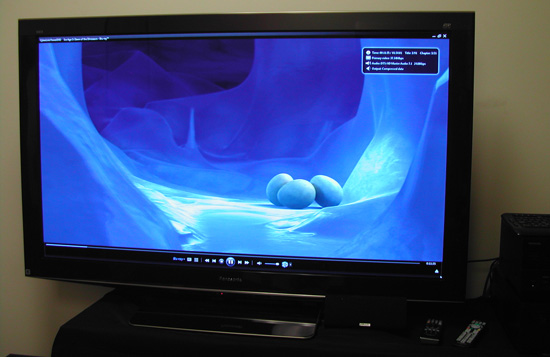Discrete HTPC GPU Shootout
by Ganesh T S on June 12, 2011 10:30 PM EST
The popularity of Intel's HD Graphics amongst HTPC enthusiasts and the success of the AMD APUs seem to indicate that the days of the discrete HTPC GPU are numbered. However, for those with legacy systems, a discrete HTPC GPU will probably be the only way to enable hardware accelerated HD playback. In the meanwhile, discrete HTPC GPUs also aim to offer more video post processing capabilities.
In this context, both AMD and NVIDIA have been serving the market with their low end GPUs. These GPUs are preferable for HTPC scenarios due to their low power consumption and ability to be passively cooled. Today, we will be taking a look at four GPUs for which passively cooled solutions exist in the market. From AMD's side, we have the 6450 and 6570, while the GT 430 and GT 520 make up the numbers from the NVIDIA side.

Gaming benchmarks are not of much interest to the HTPC user interested in a passively cooled solution. Instead of focusing on that aspect, we will evaluate factors relevant to the AV experience. After taking a look at the paper specifications of the candidates, we will describe our evaluation testbed.
We will start off the hands-on evaluation with a presentation of the HQV benchmarks. This provides the first differentiating factor.
While almost all cards (including the integrated graphics on CPUs) are able to playback HD videos with some sort of acceleration, videophiles are more demanding. They want to customize the display refresh rate to match the source frame rate of the video being played. Casual HTPC users may not recognize the subtle issues created by mismatched refresh rates. However, improper deinterlacing may lead to highly noticeable issues. We will devote a couple of sections to see how the cards handle custom refresh rates and fare at deinterlacing.
After this, we will proceed to identify a benchmark for evaluating HTPC GPUs. This benchmark gives us an idea of how fast the GPUs can decode the supported codecs, and whether faster decoding implies more time for post processing. We will see one of the cards having insane decoding speeds, and try to find out why.
Over the last few months, we have also been keeping track of some exciting open source software in the HTPC area. Aiming to simplify the player setup and also take advantage of as many features of your GPU as possible, we believe these are very close to being ready for prime time. We will have a couple of sections covering the setup and usage of these tools.
Without further ado, let us go forward and take a look at the contenders.










70 Comments
View All Comments
SouthPaw42 - Sunday, June 12, 2011 - link
To be a HTPC card it has to be passively cooled. Those a mini pc video cards.Spivonious - Monday, June 13, 2011 - link
Agreed. HTPC should be as quiet as possible. Passively-cooled video is the only choice.Mels - Monday, June 13, 2011 - link
Some of us have equipment closets dedicated to equipment using RF to communicate. Noise is definitely something most want to keep reduced but not a deal breaker for every person with a HTPC.nevcairiel - Monday, June 13, 2011 - link
Not necessarily, there are air coolers that are absolutely quiet. Only the very low-end is available with passive, which might be fine for many people, but if you want the "best" out of your HTPC, that cards won't do anymore.Look at the Gigabyte cards with the Windforce coolers, i don't hear a thing.
buzznut - Monday, June 13, 2011 - link
HIS has a passively cooled HD6570 at newegg.http://www.newegg.com/Product/Product.aspx?Item=N8...
Low profile too.
jigglywiggly - Sunday, June 12, 2011 - link
Now that the swatsitka is removed, I feel like something is missing from this review and I can no longer read it ;'(jwilliams4200 - Monday, June 13, 2011 - link
If I add up the string of numbers for the 6570, I get 193, not 197 like you have in the table. Then I see that the 430 also scores 193, and I compared the string of numbers for the 403 and the 6570, and they are identical. So why does it add up to 193 for the 430, but 197 for the 6570?ganeshts - Monday, June 13, 2011 - link
Sorry for the slip-up.The 'Ferris Wheel' and 'Roller Coaster' Compression Artifacts scores were wrong in the table under the 6570. I have updated them (no change to the total score).
jwilliams4200 - Monday, June 13, 2011 - link
Also, AMD 6450 adds up to 193, not 189.ganeshts - Monday, June 13, 2011 - link
Made a big mess copying over the values from the spreadsheet I made.. I hope everything is fixed now. Really regret the errors.